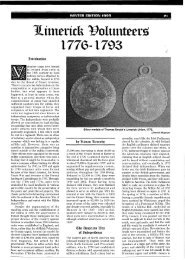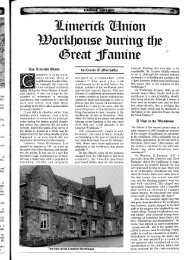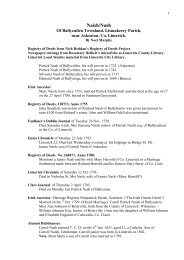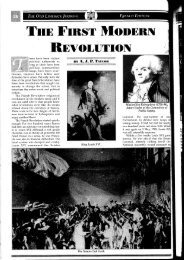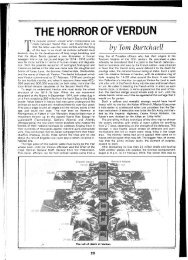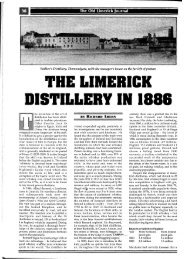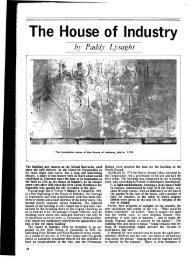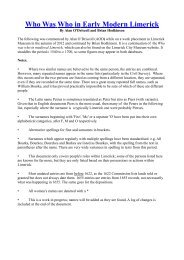pages 555 to 683 (4602 Kb) - Limerick City Council
pages 555 to 683 (4602 Kb) - Limerick City Council
pages 555 to 683 (4602 Kb) - Limerick City Council
You also want an ePaper? Increase the reach of your titles
YUMPU automatically turns print PDFs into web optimized ePapers that Google loves.
SS0 ~ISTORY OP LIMERICX.<br />
C .<br />
be king in place of lord of Ireland; but no Christian name is mentioned,<br />
although given as was cus<strong>to</strong>mary <strong>to</strong> several other bishops. The list <strong>to</strong>o, as <strong>to</strong><br />
numbers, <strong>to</strong>tally disagrees with those mentioned by the Deputy Sentleger;<br />
hence it seems questionable whether he was there, though there is no doubt<br />
he had been summoned. There is little doubt also that Bishop Quin<br />
opposed the progress of the Reformation, as we find in a letter from Sentleger<br />
<strong>to</strong> Secretary Cecil, dated 19th January, 1550-1,' the following statement:<br />
"And nowe, as tuching religion, altho it be hard <strong>to</strong> plante in<br />
men's mynds herein, yet I trust I am not slake <strong>to</strong> do what I can t'advance<br />
the same. I have caused the whole service of tlie commyon <strong>to</strong> be<br />
drawen in<strong>to</strong> Latten, mhiche shalbe shortly set furthe in print. I have<br />
caused boks <strong>to</strong> be sent <strong>to</strong> the citty of Lymik, who most gladly have<br />
condescended <strong>to</strong> ymbrace the same with all effecte, altho the Busshop<br />
therr, who is both owlde and blind, be moost agensyt it". According<br />
<strong>to</strong> Ware and Moi.rin's Patent Rolls, Bishop Quin resigned his see the<br />
9th of April, 1551, and there can be little question but that his resignation<br />
was compelled, considering what Sentleger wrote against him,<br />
and that in another letter written by him <strong>to</strong> the Duke of Somerset,<br />
18th February, 1550-1 (Shirley, p. 49), he mentions that the Lord<br />
Cnancellor, accompanied by the Master of the Rolls, had made a late<br />
journey <strong>to</strong> <strong>Limerick</strong> and Galway, and " had established the king's maties.<br />
ordres for religion in such sorte as there is greet assueraunce the same<br />
shalbe duely observed, so as I trust those parties be wthoute suspecte of<br />
adhearing <strong>to</strong> anny forreigne power". This view is confirmed by the Rev.<br />
James White in his MSS., p. 51, who writes, '' I find by an old MS. in<br />
my possession, that John Coyn was L deposed' by an order of Edward<br />
VI., for being a Catholic bishop, and that William Casey, a conformist,<br />
was put in his place". It was during Quid time that a most cruel persecution<br />
began <strong>to</strong> rage, and expended no small share of its fury. He was<br />
fated <strong>to</strong> witness the suppression of the abbeys in 1538, and the arrival<br />
of Edmond Sexten at <strong>Limerick</strong>, on special employment by hi royal<br />
master, alienating the property of the churches and uprooting the ancient<br />
landmarks. He saw his cathedral church of St. Mary's, which had f ~r<br />
centuries been dedicated <strong>to</strong> the observances of the old faith, handed<br />
over <strong>to</strong> William Casey, who, at the instance of James Earl of Desmond,<br />
according <strong>to</strong> Ware, was advanced <strong>to</strong> this see by Edward Vf., and W&<br />
made bishop by George Browne, the h t Protestant archbishop of Dublin.'<br />
He lived <strong>to</strong> see himself restcared <strong>to</strong> his see by the advent of Queen Mary <strong>to</strong><br />
the throne of England, but not <strong>to</strong> find religion in the flourishing state it<br />
had been in when he h t enjoyed the episcopal dignity, and dun'n,~ several<br />
of those years in which he had filled that exdted oace. He saw Thomaa<br />
Creagh, niayor of <strong>Limerick</strong>, A.D. 1569, proclaim Connor O'Brien, Earl<br />
of Thomond (who had fled <strong>to</strong> France, and returned and obtained pardon<br />
h London) a trai<strong>to</strong>r.3 It is strange <strong>to</strong> observe that on the very eve<br />
of the troubles which brought such deep af3iction on Church and people,<br />
$he citizens of <strong>Limerick</strong> were extending their venerable cathedral,<br />
making improvements in it, and decorating it with great taste and<br />
even elegance:- Thus we find that during the episcopacy of our prelate<br />
0<br />
Sbirley's Original Ldtm, p. 47.<br />
2 Casefs Life in Ware, p. 610, shows that he was never canonically appointed.<br />
Sezkm's Annab, ia the British Muaem.<br />
IIISTORY OF LIMERICK. 581<br />
John Quin (A.D. 1532-1533), Daniel Fitzgregory Arthur, mayor,<br />
George Creagh and William White, bailiffs; the mayor, from a principle<br />
of piety and for thc sake of his offspring, had the three aisles and the whole<br />
choir of the church of the Blcssed Virgin Mary in <strong>Limerick</strong>, laid with<br />
square polished marble flags, from whence it is <strong>to</strong> this day called bccaoaniel,<br />
(Daniel's pavement or flags) ; and the Lord blessed him with a<br />
numerous ~ffspring".~<br />
Among the deans d~uing those years, was Andrew Creagh, who resigned<br />
in 1543, and reaeived the king's pardon for some unknown offence<br />
on the day when his successor was confirmed (Rot. Put., 35th Henry VIII.).<br />
In the cathedral a s<strong>to</strong>ne is placed <strong>to</strong> his memory with the inscription:<br />
i0ecarru$+ I I<br />
This rnsrble slab had lain near the great altar; but in the alterations in<br />
1861 it was removed <strong>to</strong> the north transept, where there are some other<br />
sncient <strong>to</strong>mbs<strong>to</strong>nes of an apparently contemporaneous period, a few of<br />
which we shall notice here :<br />
Lying with the head from the western wall of the north transept, is s<br />
hiely elaborate cut s<strong>to</strong>ne, with floriated ornamentation in hi h relief,<br />
divided in<strong>to</strong> four compartments by a cross embraced in the mi dle by a<br />
~ircle. In each of the compartments is tlie figure of alion passant, the arms<br />
of the O'Briens. This ancient relic is sad <strong>to</strong> have formed the lid of<br />
a s<strong>to</strong>ne coffin, and until the alterations in 1861, it lay near the western<br />
entrance, from which it wag removed <strong>to</strong> its present place.<br />
The monument of Dean Creagh, above referred <strong>to</strong>, is placed next <strong>to</strong> the<br />
above <strong>to</strong>mbs<strong>to</strong>ne.<br />
The next in position is a floriated cross on a plain black marble sbb<br />
without any inscription.<br />
A <strong>to</strong>mbs<strong>to</strong>ne, apparently be1ong;lg <strong>to</strong> the Roche or %-ice family, is<br />
placed next <strong>to</strong> the above.<br />
A monumental slab in black letter, somewhat broken and defawd, is<br />
placed next in order. Tiii monument was erected <strong>to</strong> Thomas Mahon, and<br />
his wife Creagh; - the former died 1st November, 1631, the latter November<br />
2nd, 1637.<br />
On the deprivation of William Casey, who had been advanced, as we<br />
have seen, by Edward VI., from the rec<strong>to</strong>ry of Kilcornan, on the recommendation<br />
of James, Earl of Desmond, Hugh Lacy, or Lees, a canon of<br />
<strong>Limerick</strong>, was appointed by Queen 3Iary.P The following abstract of the<br />
royal letter is in Monin's Calendar of the Patent Idolls: The queen <strong>to</strong><br />
Arthur MSS. These, we suppose, were the tiles which were taken up in the repairs of the<br />
cathedral in 1861, and which were similar in many respects <strong>to</strong> the ancient encaustio tiles found<br />
in Mellifont Abbey, Christ Church, and St. Patrick's. Dublin, and in other abbeys and churches,<br />
ad a dascriptive catalogue of which has been published by Thomas Oldham, Esq, in his work on<br />
ancient Irish pavement iiles. The tiles of St. Mary's were encaustic, with the lily impressed on them<br />
-me were vitr&d, and the lily also impressed on them. [I have a few specimens of them.]<br />
S He was of the ,pat De Lacy family of the County of <strong>Limerick</strong>.<br />
%



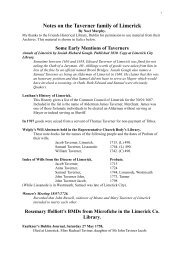

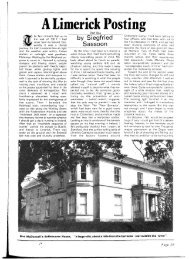
![The Galbally farmer [poem] by Darby Ryan - Limerick City Council](https://img.yumpu.com/24792577/1/190x260/the-galbally-farmer-poem-by-darby-ryan-limerick-city-council.jpg?quality=85)
